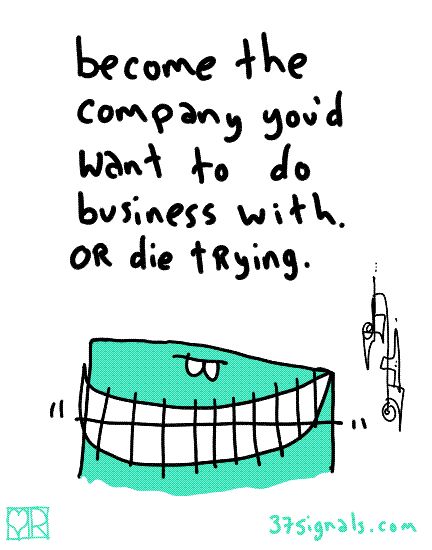
A cartoon by Hugh MacLeod: “The idea comes from a core value taken right off [37signals’] homepage. They use a lot of blue and green in their graphic design, so I went with something blue-greeny.” Printable version also available.
You’re reading Signal v. Noise, a publication about the web by Basecamp since 1999. Happy !

A cartoon by Hugh MacLeod: “The idea comes from a core value taken right off [37signals’] homepage. They use a lot of blue and green in their graphic design, so I went with something blue-greeny.” Printable version also available.
Customers want to actually use a tool before giving up their info. So it’s interesting to see more and more sites letting you do the thing first and moving to collect your info later (or not bothering at all)...
Optimizely
Optimizely bills itself as “A/B testing you’ll actually use.” The big call to action on the home page is a field to enter your website URL.

That takes you to a page where you can start annotating your website in order to set up your A/B test.
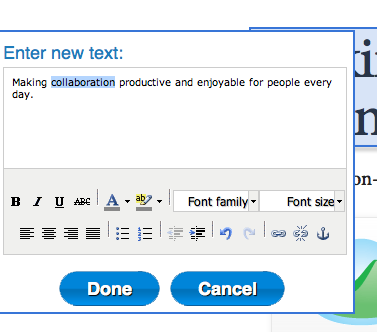
When you click save, that’s when the site prompts you to create an account.
Give the OK
Give the OK is an online feedback and approval tool. The home page offers a big “upload your first proof” button.

The resulting page gives you a link to share with your client. And that’s when the site encourages you to sign up for an account to track further iterations.
Continued…If you want to track further design iterations and harness the true power of Give The Ok, sign up using the form below.
While it’s nice to dine out on the latest shiny acquisition, you have to get down to the hard work of making sure it succeeds for the long haul. AOL has found a way to acquire what it cannot build, but it still hasn’t found a way to hang on to what it has.
Experts go with what they know. And they’ll often insist something needs to take a long time. But when you don’t have tons of resources, you need to ask if there’s a simpler, judo way to get the impact you desire. Sometimes there’s a better way than the “best” way.
I thought of this while watching “The Fighter” over the weekend. There’s a making of extra on the DVD where Mark Wahlberg, who starred in and produced the film, talks about how all the fight scenes were filmed with an actual HBO fight crew. He mentions that going this route allowed them to shoot these scenes in a fraction of the time it usually takes.
Every filmmaker that we talked to about directing this movie was like you can’t shoot the fights in 20 days, you need 35 days. And I said, “Well, we’re going to shoot the whole movie in 33 days and we’re going to shoot all the fights in three days.” And they said, “How are you going to do that? It’s never going to work.” And I said, “Because we’re going to film them like actual fights.”
So we literally did every fight from the actual beginning, coming out of the dressing room into the arena, into the ring, first bell, introductions, to the last bell, and everything. And we just did it over and over and over again.
And what I kept telling everybody is that HBO does it in one take and they don’t know what’s going to happen and they never miss a thing. We have the luxury of showing them what we’re going to do in the morning before we shoot it and doing it over and over and over again. So why do you need 20 days? For what? To jerk each other off? To touch up your makeup? To go in the trailer and take a nap?
We’re not talking about putting the camera in there and saying, “OK, we’re going to do a stunt punch here.” No, we’re going in there and beat the shit out of each other and we’re going to make it real.
Judging by the film’s success at The Oscars and the box office, the plan worked. And it’s a great example of reframing the problem and asking the right questions.
All these filmmakers insisted on a month+ to film the scenes because conventional wisdom says that’s the “right” way to do it. But sometimes conventional wisdom is more convention, less wisdom. And that’s when it pays off to take a questioning attitude and challenge assumptions.
Would taking the extra time with these scenes really add significant value? Sure, there’d be more slow motion, spit-flying, macro closeups. But would those shots really have made it a better film?
It ties in with another great question to ask: What problem are you solving? The goal was to make the fights seem real. Not to make them look good. To seem real. Focusing on that changes the requirements.
And that leads to another good question you should always come back to: Is there an easier way? The HBO fight crew is made up of experts at filming fights. They don’t need to be taught how to make it look real. They’re used to capturing a fight in one take — and that’s without knowing what will happen beforehand. Shooting this way is a piece of cake for them.
And maybe the most important question: What’s the opportunity cost? The whole film had a shooting calendar of 33 days. Filming it the HBO way means the movie gets made. A longer, pricier approach might have doomed the film and prevented it from ever being shot in the first place.
Most of us aren’t filming fight scenes. But the way Wahlberg and his team challenged assumptions and questioned traditional “best practices” is something that can be applied to all kinds of arenas, not just boxing ones.
Below: (Spoiler Alert! Don’t watch if you don’t want to know the outcome of a fight in the film.) This video compares Micky Ward vs. Shea Neary in “The Fighter” with the real fight.
Part of growing is reevaluating. Running the business we have now is simply not the same as the one we ran five years ago. That’s why we’re announcing a dramatic shift. In light of recent difficulties we’ve faced working effectively as a virtual organization, we will be relocating our entire staff to Chicago. No one on our team will be permitted to work remotely. We realize this runs counter to much of the advice we’ve given in the past, so allow us to explain why we’re shifting course.
We used to believe time zones didn’t matter
We were wrong. In the past months we’ve experimented with holding two-hour status meetings every Monday, Wednesday, and Friday. But with people located all over the map, timing has proven to be difficult. Uniting our staff will fix this.
As we’ve grown, security has become more important.
Sure, we trust our employees. But we don’t know who else is in their house. What happens if there’s a messy divorce? Or some teen pranksters lurking around? We can’t risk it. Now everyone will get a dedicated work iMac instead of a laptop. This iMac will be chained down in our new office. Work programming and design is no longer allowed on our staff’s personal computers. (Staffers are still free to play around with open source toys, if they must, as long as they do so on their own time)
We also want to make sure our productivity is best of breed
If we demand 99.9% uptime from our servers, we should demand that amount of productivity from our employees too. To that end, everyone will work in our kitchen, sitting around a big table. This will make it harder for any team member to slip into “lazy mode” on Facebook, Reddit, Hacker News, or Twitter. We pay for all hands on deck and that’s what we’ll get with our new setup.
Given the incredible design of our new office, we want our employees to take just as much pride in their own physical appearance too
So we’re instituting a dress policy. We have created an official 37signals uniform, with help from our friends across the street at Threadless. It is a unisex, one-piece, uniform that is functional and minimalist, just like our apps. We are confident our employees will love their new mandated attire.
Change is never easy. But we’re willing to do whatever it takes to be the most efficient company we can be. Now please excuse us, we’re off to get more productive. And secure. And dressed the same.
P.S: Please refrain from posting any snarky comments on this serious matter. Our employees are getting the word at the same time you are (openness is the best policy) and we’d like them to have a chance to tell their families before having to read something inappropriate from an anonymous coward.
You asked for it. We listened. We’re proud to announce that Basecamp Enterprise Server for Windows NT is available for mail-order today!
It’s the Basecamp you know and love packed onto 37 easy-to-install 3.5 floppy disks. It’s as easy as A:\install.exe.
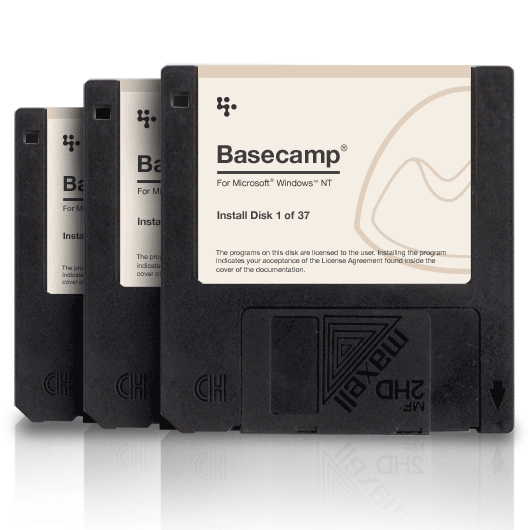
If you’re interested in purchasing Basecamp Enterprise Server for Windows NT just send a self-addressed stamped envelope along with $1,788 to:
37signals, ATTN: BCNT, 30 North Racine #200, Chicago, Illinois 60607 USA
Next week Trevor Turk will be joining 37signals as our newest programmer. His application impressed us with great code, open-source contributions, and strong writing skills. Plus he’s in Chicago which is an added bonus. Welcome on board, Trevor!
We’re still looking to add one more programmer to the team. Please see the job posting.
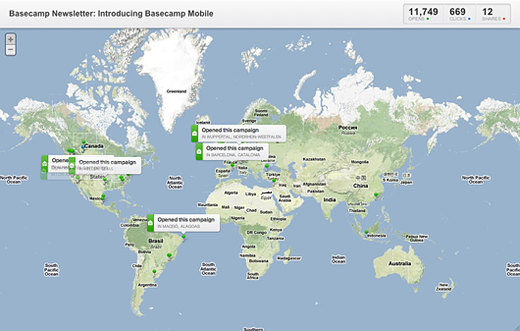
Campaign Monitor’s cool Worldview feature on our latest Basecamp Mobile newsletter
Back in 2001, Coudal Partners was on the ropes fiscally. And according to Jim Coudal, it’s the best thing that could have happened.
"After 9/11, we lost a lot of business. And we were in trouble. It wasn’t any problem of ours. One company got bought and other people cut back on their spending," he explains. "It’s the best thing that ever happened to us because we pulled back and said, ‘Well, do we wanna build up this whole thing again and go chase business that we don’t want and get into pitches and win or not win business based on the whims of people who are stupider than we are? Or is there another way?’"
It was the culmination of years of frustration from doing client work. "We never really maximized our creative potential by, I can say it, whoring ourselves out to people who knew less than we did," he says. "If you have the skills to do client work, you have the skills to make your own product. You’re selling yourself short by selling that on a work for hire basis."
To illustrate his point, he brings up the product that now generates the most revenue for the company: Field Notes. "We do a good job marketing it," he explains. "We sell hundreds of thousands of these things and we make money out of it. If I did that same work for this other company called Yard Notes and we did exactly the same work, they’d paid us $50,000 for the work and then sell a million of the memo books. We didn’t get any of that million that our work did. From an economic standpoint, that’s the essential inequality. Your own stuff is potentially more lucrative and also comes with peace of mind — and not having those ulcers that come with knowing full well that you know better than the client but still have to kneel down."
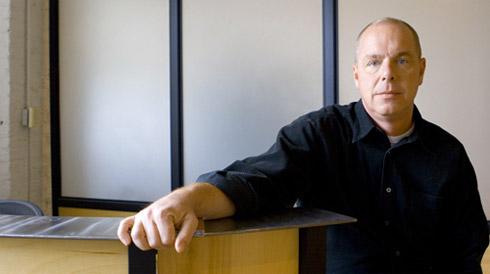
Evolving goals
Coudal started out decades ago as a creative director for a big Chicago ad agency working on high profile accounts. But even then, he wasn’t happy with the system. He’d reach goals he set for himself yet still found himself dissatisfied.
"There’s this great quote by Dan Gilbert. He said that the reason that most of us are so unhappy most of the time is that we make our goals for the people we are when we set them, not for the people we’re gonna be when we reach them," Coudal explains. “And when I started at an ad agency I said, ‘I need to be a creative director. I need to be a hotshot creative director in an agency that’s highly visible.’ And I got there and was miserable doing work I wasn’t particularly proud of for people I didn’t like."
That’s when he left and, along with partners Susan Everett and Kevin Guilfoile, started a new eponymous agency. Despite the new company, the result was a familiar feeling. He says, "I wanted to bill $20 million and win some Addy Awards. That’s what we wanted to do. So we just kept pushing. And then adding people and growing and working for clients and we never evaluated whether this is really what we wanted to do. We were just trying to get to this arbitrary goal for no reason at all.
"I had set goals early without reevaluating where I was in terms of my happiness as a person. And I had to feed the beast. If you start adding people, then you gotta bring in more work and sometimes you gotta bring in work that you’re not particularly fond of in order to make the payroll to pay the more people that you’re hiring to do the work that you’re not particularly fond of.
“I had set goals early without reevaluating where I was in terms of my happiness as a person. And I had to feed the beast.”
"One thing leads to another and all of a sudden you look at the work you’re producing and you’re not proud of it and you’re out at the bar after work making fun of your clients. That’s funny for a little while, but that’s no way to go through life. It makes you jaded. If you don’t like your job, there’s something wrong. And going to the bar and complaining about your job is a symptom of something wrong.”
Continued…They are not new lessons. Never owe any money you can’t pay tomorrow morning. Never let the markets dictate your actions. Always be in a position to play your own game. Never take on more risks than you can handle…Good businesses, good management, plenty of liquidity, always having a loaded gun; if you play by those principles you will do fine no matter what happens. And you don’t ever know what’s going to happen…
I mean, when times are good, it is kind of like Cinderella at the ball. She knew at midnight that everything was going to turn into pumpkins and mice, but it was just so much damn fun, dancing there, the guys looked better and the drinks got more frequent and there were no clocks on the wall.
And that’s what happened with capitalism. We have a lot of fun as the bubble blows up, and we all think we are going to get out five minutes before midnight, but there are no clocks on the wall.